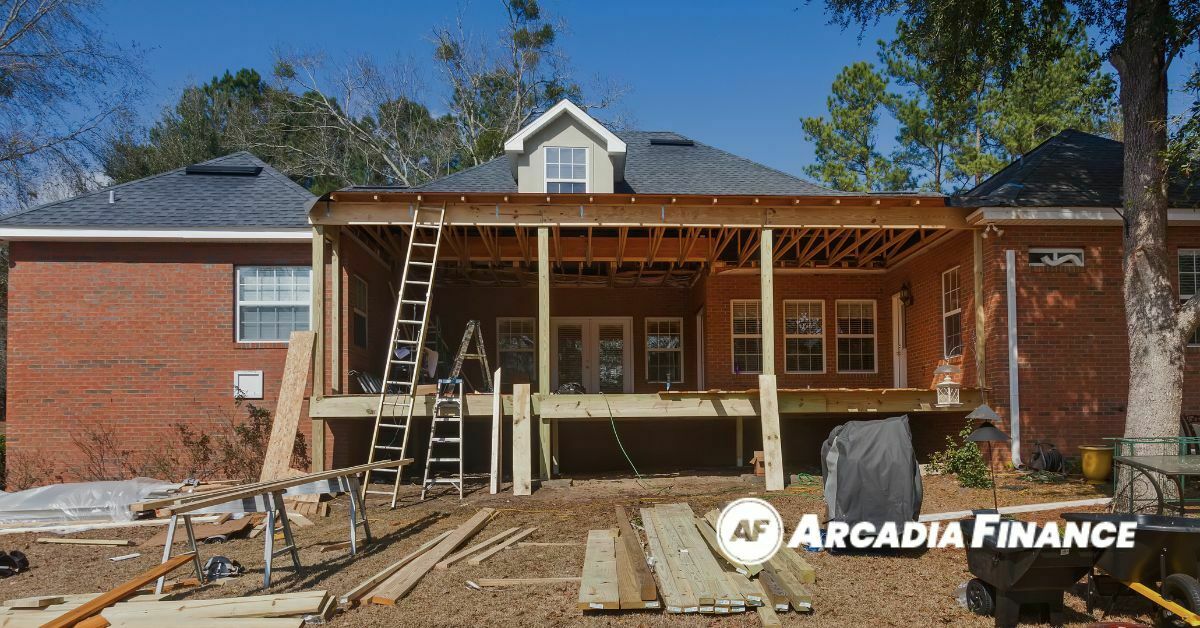
In the grand adventure of homeownership, envisioning changes to your living space can be both exhilarating and daunting. Every home, be it a Victorian townhouse or a modern loft, tells a unique story. Over time, though, rooms might feel dated, or spaces may no longer align with the changing dynamics of your family. The dream of refreshing these spaces often comes with a price tag that may not fit comfortably within your monthly budget. Not everyone has a reservoir of savings waiting for that kitchen remodel or loft extension. This gap between aspiration and finance is where the quest for funding solutions begins. Securing the right financing can be the linchpin that ensures your dream changes materialize without destabilizing your financial well-being.
Key Takeaways
- Tax Benefits: Home improvement projects can offer tax deductions on loan interests, potentially reduce capital gains tax, and even allow VAT refunds on building materials under certain conditions.
- Insurance Adjustments: Before starting any home improvement, notify your insurance provider. Post-project, re-evaluate to ensure adequate coverage.
- Documentation is Important: Maintain meticulous records of all transactions, contracts, and invoices to leverage tax benefits fully.
- Liability Coverage: Protect against potential claims if workers or contractors suffer injuries on your property during the improvement process.

Assessing and Prioritising Your Home Improvement Needs
Before plunging headfirst into the world of home enhancements, it’s important to step back and assess the entirety of your project. This introspection not only makes the journey smoother but can also save you from unforeseen hitches and costs.
Estimating the Costs
The eternal question: How much is this going to set me back? Though there’s no magic wand to give an instant figure, a structured approach can get you close. Start by listing down all the modifications you wish to make, from that swanky new kitchen island to the solar panels on your roof. For each item, do a bit of market research. Local home improvement stores, online marketplaces, and consultation with contractors can provide a ballpark estimate. While you’re at it, remember to account for:
- Labour costs, which often fluctuate based on skill and experience.
- Material costs, influenced by brand and quality.
- Unforeseen expenses (trust us, they’ll pop up!). Allocate around 10-15% of your total budget for these surprise costs.
By the end of this exercise, you’ll have a comprehensive financial picture. This isn’t just about numbers; it’s about grounding your dream project.
Determining Project Scope and ROI
The scope of your project goes hand-in-hand with your budget. Ask yourself: What changes will provide the most significant impact on your living experience? Is it the modern bathroom with a rain shower, or is it the open-plan kitchen that seamlessly merges with the dining space?
Once you’ve ranked your changes, it’s time to think long-term. Consider the Return on Investment (ROI) for each project. For instance, while a garden redesign might elevate your outdoor experience, converting your loft into an additional bedroom could boost your property’s market value substantially more. It’s a delicate balance between personal aspirations and future financial gain. Resources like property journals or consultations with estate agents can give you a glimpse into what home improvements have the best ROI in your area.
Once you’ve secured your first home, you might consider making improvements to increase its value or better suit your lifestyle. Gain essential insights on how to manage these projects financially by reading our detailed guide, Tips on Buying Your First House, to ensure you make informed decisions from the outset.
Traditional Financing Options
When looking at traditional paths to gather the funds for home enhancements, there’s a well-trodden road ahead. It’s dotted with various signposts, each offering its unique benefits and considerations.
Personal Loans, Home Equity Loans, and Second Mortgages
Personal Loans: The straightforward option for many. These unsecured loans are often the first port of call for those seeking funds without tying it directly to their property. Since they’re unsecured, lenders determine eligibility based on credit score, income, and debt levels. The beauty of personal loans lies in their simplicity: fixed interest rates, fixed monthly payments, and a set loan term.
Home Equity Loans: Think of this as a second mortgage on your home. Here, you’re borrowing against the equity you’ve built up in your property. The amount you can borrow generally revolves around the difference between your home’s current value and what you owe on your primary mortgage. Since it’s secured against your home, it often comes with lower interest rates compared to personal loans. But tread carefully; if you default, the lender can take your home.
Second Mortgages: Similar to home equity loans but with a twist. A second mortgage allows homeowners to borrow money, using their home’s equity as collateral. This means you’ll have two monthly mortgage payments: one for your primary mortgage and one for the second. The interest rates might be slightly higher than home equity loans, but they usually beat out credit card rates.
Thinking of giving your home a fresh new look? Personal loans can provide the perfect financial boost for renovations and upgrades. Find out more about this and other amazing uses of personal loans in our comprehensive guide: What Can a Personal Loan Be Used For?
The Role of Credit Cards in Home Improvements
For some, the plastic in their wallets becomes the knight in shining armor. Credit cards can be especially handy for smaller projects or immediate fixes that can’t wait. Opting for a card with a 0% introductory APR can mean no interest for a set period, letting you pay back as and when you can. Plus, there’s the bonus of rewards or cashback on some cards. However, tread with caution. Once the introductory period elapses, interest rates can skyrocket. And, if you’re only paying the minimum each month, that dreamy new conservatory could end up costing way more in the long run. Credit cards are like spices in a dish – best used judiciously.
Alternative Financing Methods
Beyond the familiar realm of bank loans and credit cards lies a vibrant tapestry of alternative funding methods, each designed to cater to specific needs and scenarios. Venturing into this less-trodden territory could unveil some remarkable opportunities to fund your home improvement dreams.
Government Grants for Homeowners
Let’s begin our exploration with a source that many homeowners might overlook: the government. Believe it or not, there are myriad schemes rolled out to help homeowners make their dwellings more sustainable, efficient, or even just safer. These grants, often tied to environmental or energy-saving initiatives, can significantly reduce the burden on your pocket.
For instance, if you’re thinking of improving your home’s insulation, installing solar panels, or upgrading to energy-efficient heating systems, there might be a government grant waiting to subsidize a portion of the costs. The beauty of these grants is their non-repayable nature. In essence, it’s free money towards a greener home!
It’s always a good shout to regularly check with local councils or government websites to stay updated on available grants. Even if you don’t qualify today, the rapidly evolving nature of these initiatives means something suitable might be just around the corner.
Crowdfunding and Peer-to-Peer Lending
In an age dominated by technology and social connectivity, why not leverage the power of community for home improvements? Enter: crowdfunding. Platforms like Kickstarter or GoFundMe allow individuals to present their projects to the public, inviting contributions in return for rewards or simply goodwill. While traditionally associated with entrepreneurial ventures or personal causes, there’s no rule against using it for home projects. Perhaps you’re restoring a historical property or building a community space within your home – stories that resonate can attract contributions.
Then there’s peer-to-peer (P2P) lending, the modern twist on borrowing money. Platforms like Zopa or Funding Circle connect borrowers directly with individual lenders, bypassing traditional financial institutions. The result? Often, more favorable interest rates and a streamlined process. However, remember that your credit score still plays a role in the interest rate you’re offered.
» Discover: Air conditioning installation expenses!
Budgeting and Financial Planning
Creating a Tailored Budget
The cornerstone of any successful home improvement venture lies in a bespoke budget that mirrors your aspirations while keeping a tight leash on realities. Crafting this tailored budget isn’t rocket science, but it does require diligence. Start with an exhaustive list of all envisaged expenses. Dive into the nitty-gritty: materials, labor, permits, and even post-project décor.
Now, juxtapose this with your available funds. Whether it’s savings, loans, or a mix of various sources, having clarity on your financial reservoir helps in setting boundaries. Once you’ve paired expenses with resources:
- Set aside a contingency fund, typically 10-15% of your overall budget. This ensures unexpected hitches don’t derail your plans.
- Regularly track and update. As you proceed, keep an eagle eye on expenditures, adjusting to ensure you remain within the earmarked limits.
Avoiding Common Financial Pitfalls
The path of home improvement, though rewarding, is strewn with potential pitfalls. Being aware of these financial traps can save you from heartaches and empty coffers. Here are some to steer clear of:
Opting for the cheapest bid: While it’s tempting to save on contractor costs, remember that you often get what you pay for. An inexperienced contractor can lead to costly fixes later.
Overcapitalising: It’s easy to get swept up in the euphoria and over-improve. Adding a gold-plated bathtub might seem fancy, but if it’s way beyond the norm for your neighborhood, you’re unlikely to recoup the costs when selling.
Skipping the fine print: Whether it’s a loan agreement or a contractor’s contract, always scrutinize the details. Hidden fees, penalties, or vague clauses can lead to unpleasant surprises.
Before diving into home improvement projects, it’s crucial to understand all the costs associated with property ownership. Transfer fees on property can significantly impact your budget, so it’s essential to factor them in when planning your finances.
Navigating Contractors and Quotes
Choosing the Right Contractor
A contractor isn’t merely someone who brings bricks and mortar to life; they’re the very architects of your vision. Identifying the ideal fit starts with research. Word of mouth remains a trusted ally. Ask around – friends, family, neighbors. Their experiences can provide invaluable insights.
When you’ve shortlisted potential candidates:
Review their portfolio: This offers a window into their style, quality, and the kind of projects they’ve handled.
Check credentials: Ensure they’re licensed, insured, and affiliated with professional bodies in the construction arena.
Conduct interviews: Meeting face-to-face or virtually provides a sense of their professionalism, approach, and compatibility with your expectations.
Remember, it’s not just about skill but also communication, understanding, and a shared vision of the end goal.
Understanding and Comparing Quotes Effectively
Once you’ve identified potential contractors, the next step involves diving into the world of quotes. These are more than just numbers; they’re a blueprint of your project’s financial landscape. But how do you navigate these quotes to ensure you’re making an apple-to-apple comparison?
Itemisation is key: A good quote isn’t just a lump sum amount. It breaks down costs – labor, materials, and miscellaneous expenses. This granularity allows for easier comparison between contractors.
Clarify inclusions and exclusions: Does the quote include VAT? What about cleanup post-project or any potential fees for changes?
Ask about contingencies: Projects can often face unforeseen challenges. How a contractor factors for these in their quote can provide insight into their experience and foresight.
Lastly, don’t get fixated on just the numbers. A significantly lower quote might mean compromises in quality or even potential hidden costs.
About Arcadia Finance
Get your loan effortlessly via Arcadia Finance. Zero application charges, with the option to choose from 19 dependable lenders. All lenders comply with regulations from the National Credit Regulator in South Africa.
Tax and Insurance Considerations
In the vibrant tapestry of home improvement, the nuances of tax and insurance weave subtle but potent threads. While they may lack the visceral thrill of choosing tiles or fixtures, they hold the key to maximizing financial efficiency and safeguarding your investment. Ignoring these considerations is akin to painting without priming the canvas. Let’s illuminate these two domains, unraveling the interplay of tax benefits and the protective shield of insurance.
Tax Benefits and Documentation
The realm of taxation, with its intricate labyrinths, hides golden nuggets for homeowners undertaking improvement projects. Leveraging these tax benefits can lead to appreciable fiscal advantages.
- Home Improvement Loans: Interest paid on loans specifically taken out for home improvement can often be claimed against tax, subject to certain conditions. Ensure that you maintain comprehensive records and receipts.
- Capital Gains: While selling, home improvements can augment the property’s cost basis, potentially reducing capital gains tax.
- VAT Refunds: In specific scenarios, homeowners can reclaim VAT paid on building materials, especially for new builds or extensive renovation projects.
Maintaining meticulous documentation is paramount. Invoices, contracts, and payment proofs should be systematically archived. They’re not just financial breadcrumbs; they’re your passport to the world of tax benefits.
Ensuring Adequate Insurance Coverage
The symphony of home improvement can sometimes hit unexpected notes. That’s where insurance steps in, cushioning the impact of unforeseen misadventures. Reviewing and adjusting your coverage is pivotal.
Inform your insurer: Before diving into your project, inform your insurance provider. Major improvements can influence your home’s value, affecting replacement costs.
Check for adequate liability coverage: If contractors or workers suffer injuries on your property, liability coverage becomes a bulwark against potential claims.
Post-project adjustments: Once your project concludes, reassess. Your rejuvenated home might necessitate higher coverage, ensuring you’re not left underinsured.
If you vacate your property during extensive renovations, ensure your coverage isn’t jeopardized. Some policies might have stipulations about homes left unoccupied for extended durations.
Conclusion
While the allure of fresh designs and vibrant spaces captures the imagination, the subtler, yet equally critical elements of tax, insurance, and finance serve as the bedrock of a successful project. By being astute about tax benefits, vigilant with insurance coverages, and savvy in navigating the financial terrains, you not only bring to life your dream space but also ensure it stands on robust fiscal ground. As you step back to admire the transformed canvas of your home, take a moment to appreciate the intricate dance of creativity and strategy that made it all possible. With every tile laid and every wall painted, you’ve not just revamped a space; you’ve orchestrated a masterpiece of planning, passion, and prudence.
Frequently Asked Questions
When deciding on financing, it’s essential to assess your individual needs and financial health. Start by evaluating your credit score; a higher score can open doors to lower interest rates. Next, consider the scale of your project. For smaller endeavors, credit cards or personal loans might suffice, while extensive renovations could necessitate a home equity loan. Factor in the loan’s interest rate, terms, and monthly payments. Finally, consider any additional benefits such as tax deductions associated with certain home improvement loans. Aligning these elements with your fiscal situation can steer you toward the ideal financing avenue.
The push towards sustainability has birthed specialized financing options for eco-friendly renovations. Green loans or energy-efficient mortgages cater specifically to homeowners eyeing sustainable upgrades. These often come with favorable interest rates or terms, rewarding the environmentally conscious. Before diving in, ensure that your improvements meet the loan’s green criteria, which might revolve around energy efficiency, sustainable materials, or water conservation.
Selecting a reliable contractor is a blend of research and instinct. Begin by seeking personal recommendations from friends or family who’ve recently undertaken home projects. Dive deep into online reviews, but remember to discern genuine feedback from the noise. Licensing is important; a licensed contractor underscores professionalism and adherence to local regulations. Further, enquire about warranties or guarantees they offer on their work. A face-to-face meeting can also provide insights into their expertise, transparency, and compatibility with your vision.
While budgeting, it’s prudent to remember that renovations, like icebergs, might have unseen elements. Contingency funds are a wise inclusion, accounting for about 10-20% of your total budget. Costs can sneak up in the form of permits, disposal fees, or unexpected structural issues like faulty wiring or plumbing. Additionally, fluctuations in material prices or last-minute design tweaks can alter the financial landscape. Keeping a flexible, well-researched budget can cushion against these hidden costs.
Enhancing property value through improvements revolves around strategic choices and quality execution. Prioritize projects that boost functional and aesthetic appeal, such as kitchen or bathroom upgrades, expansions, or landscaping. Stay informed about current real estate trends, and understand what potential buyers seek. For instance, energy-efficient homes or smart homes might be the current rave. Collaborating with professionals, be it designers or real estate agents, can provide insights into value-augmenting improvements. Above all, balance personal preferences with broad market appeal.
Fast, uncomplicated, and trustworthy loan comparisons
At Arcadia Finance, you can compare loan offers from multiple lenders with no obligation and free of charge. Get a clear overview of your options and choose the best deal for you.
Fill out our form today to easily compare interest rates from 19 banks and find the right loan for you.



